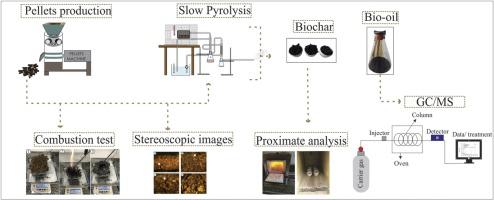Industrial Crops and Products ( IF 5.9 ) Pub Date : 2020-06-30 , DOI: 10.1016/j.indcrop.2020.112731 C. Setter , F.A. Borges , C.R. Cardoso , R.F. Mendes , T.J.P. Oliveira

|
The growing market for pellets used to produce energy requires research on new feedstocks and technologies (pyrolysis) that increase the energy potential of these products. Thus, the objective of this study was to produce pellets from coffee residues, evaluate their energy potential, pyrolyze the pellets via slow pyrolysis and characterize the final products of the process (bio-oil and biochar). The pellets were produced from coffee husks in a pelletizer; some of the pellets were used for the combustion test, and others were used in the slow pyrolysis process. The efficiency in compacting the bulk biomass to obtain solid fuels was demonstrated by calculating the energy density. The pellet formation efficiency was also evaluated using stereoscopic images. Slow pyrolysis was performed at three final temperatures: 400 °C, 450 °C and 500 °C; the final residence time was 1 h. The product yields were calculated at the end of the pyrolysis process. The chemical compounds present in the bio-oil were identified by gas chromatography mass spectrometry (GC–MS), and the proximate analysis, higher heating values and Fourier transform infrared spectroscopy (FTIR) of the biochar were determined. The results showed that the prior addition of water to the coffee husk particles resulted in unstable pellets. The energy density of the pellets was statistically higher than that of the coffee husk. The combustion test allowed the combustion profile of the pellets to be determined, in which high temperatures and uniform burning were obtained. The pyrolysis product yields were influenced by the process final temperature. The biochar yield decreased with increasing temperatures; however, the fixed carbon and calorific values of the biochar collected at 450 °C were higher than the values of the biochar collected at other temperatures. The maximum yield of bio-oil was obtained at 450 °C, while the gas yields were the highest at 500 °C. The bio-oils obtained by higher pyrolysis temperatures comprised greater amounts of phenolic (phenol, phenol, 2-methyl- and phenol, 3-methyl-) and nitrogenous (caffeine) compounds. Lower temperatures yielded more esters (hexanedioic acid and bis(2-ethylhexyl) ester). The low atomic ratios H/C and O/C proved that temperatures ≥ 400 °C made the biochar more aromatic and carbonaceous, this fact was evidenced by the FTIR analysis. It is concluded that the coffee husk pelletizing process is a convenient alternative to obtain higher energy efficiency. Furthermore, from the energetic properties of the biochar the coffee husk has the potential to be used as fuel.
中文翻译:

由咖啡渣产生的颗粒的能量质量:通过缓慢热解获得的产品的表征
用于生产能源的颗粒的不断增长的市场要求对新的原料和技术(热解)进行研究,以增加这些产品的能源潜力。因此,这项研究的目的是从咖啡渣中制得颗粒,评估其能量潜力,通过缓慢的热解来热解颗粒,并表征该过程的最终产品(生物油和生物炭)。颗粒由造粒机中的咖啡果皮制成;一些颗粒用于燃烧测试,另一些用于慢速热解过程。通过计算能量密度证明了压实散装生物质以获得固体燃料的效率。还使用立体图像评估颗粒形成效率。在三个最终温度下进行缓慢的热解:400°C,450°C和500°C;最终停留时间为1小时。在热解过程结束时计算产物收率。通过气相色谱质谱法(GC-MS)鉴定了生物油中存在的化合物,并确定了生物炭的直接分析,较高的发热量和傅里叶变换红外光谱(FTIR)。结果表明,事先将水加入到咖啡果壳颗粒中会导致颗粒不稳定。颗粒的能量密度在统计学上高于咖啡果壳的能量密度。燃烧试验可以确定丸粒的燃烧曲线,其中获得了高温和均匀燃烧。热解产物的产率受工艺最终温度的影响。生物炭产量随着温度的升高而降低。然而,在450°C下收集的生物炭的固定碳和热值高于在其他温度下收集的生物炭的值。在450°C时可获得最大的生物油产率,而在500°C时可获得最高的气体产率。通过较高的热解温度获得的生物油包含大量的酚类(苯酚,苯酚,2-甲基和苯酚,3-甲基-)和含氮(咖啡因)化合物。较低的温度产生更多的酯(己二酸和双(2-乙基己基)酯)。低原子比的H / C和O / C证明,温度≥400°C使生物炭更加芳香和含碳,这一事实已通过FTIR分析得到了证明。结论是,咖啡果壳制粒工艺是获得较高能量效率的便利替代方法。此外,



























 京公网安备 11010802027423号
京公网安备 11010802027423号